alternator SSANGYONG KORANDO 2013 Service Manual
[x] Cancel search | Manufacturer: SSANGYONG, Model Year: 2013, Model line: KORANDO, Model: SSANGYONG KORANDO 2013Pages: 1336, PDF Size: 92.18 MB
Page 185 of 1336
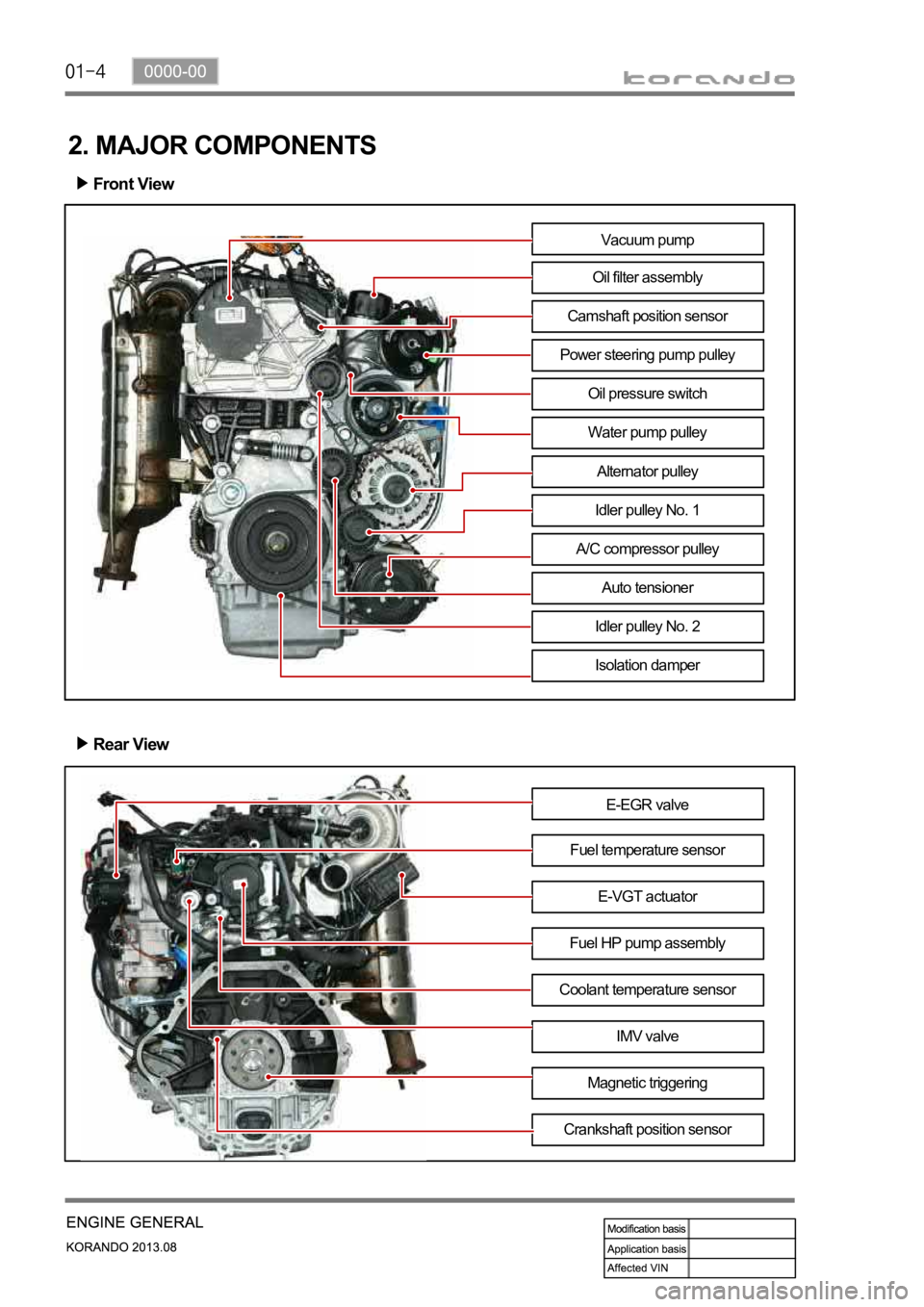
2. MAJOR COMPONENTS
Front View
Rear View
E-EGR valve
Fuel temperature sensor
Fuel HP pump assemblyE-VGT actuator
Coolant temperature sensor
IMV valve
Magnetic triggering
Crankshaft position sensor
Vacuum pump
Oil filter assembly
Camshaft position sensor
Power steering pump pulley
Water pump pulley
Alternator pulley
Idler pulley No. 1
A/C compressor pulley
Auto tensioner
Idler pulley No. 2
Isolation damper
Oil pressure switch
Page 201 of 1336

0000-00
Knock sensor2-
Cam position sensor
1 10~14Nm -
T-MAP pressure sensor
1-
Exhaust manifold M8 10
-
Turbocharger M8 3
-
T/C support bracket bolt
1
-
T/C support bracket bolt
M8 1
-
T/C oil supply pipeM6(block side) 1
-
M6(turbo side) 1
-
T/C oil return pipe
(turbo side)2-
(block side)2-
EGR valve
3-
EGR pipe bolt
(Intake side)
2-
EGR pipe bolt
(EGR cooler side)
2-
Oil pressure sensor M24 1 Max. 50Nm -
Component Size
QuantityTightening torque
(Nm)Remark
(Total torque)
Hot water inlet pipe
2-
Alternator
1Lower
1Upper
A/C compressor
4-
A/C bracket
4-
Intake manifold
2-
6-
Oil filter module
6-
1-
2-
Page 212 of 1336
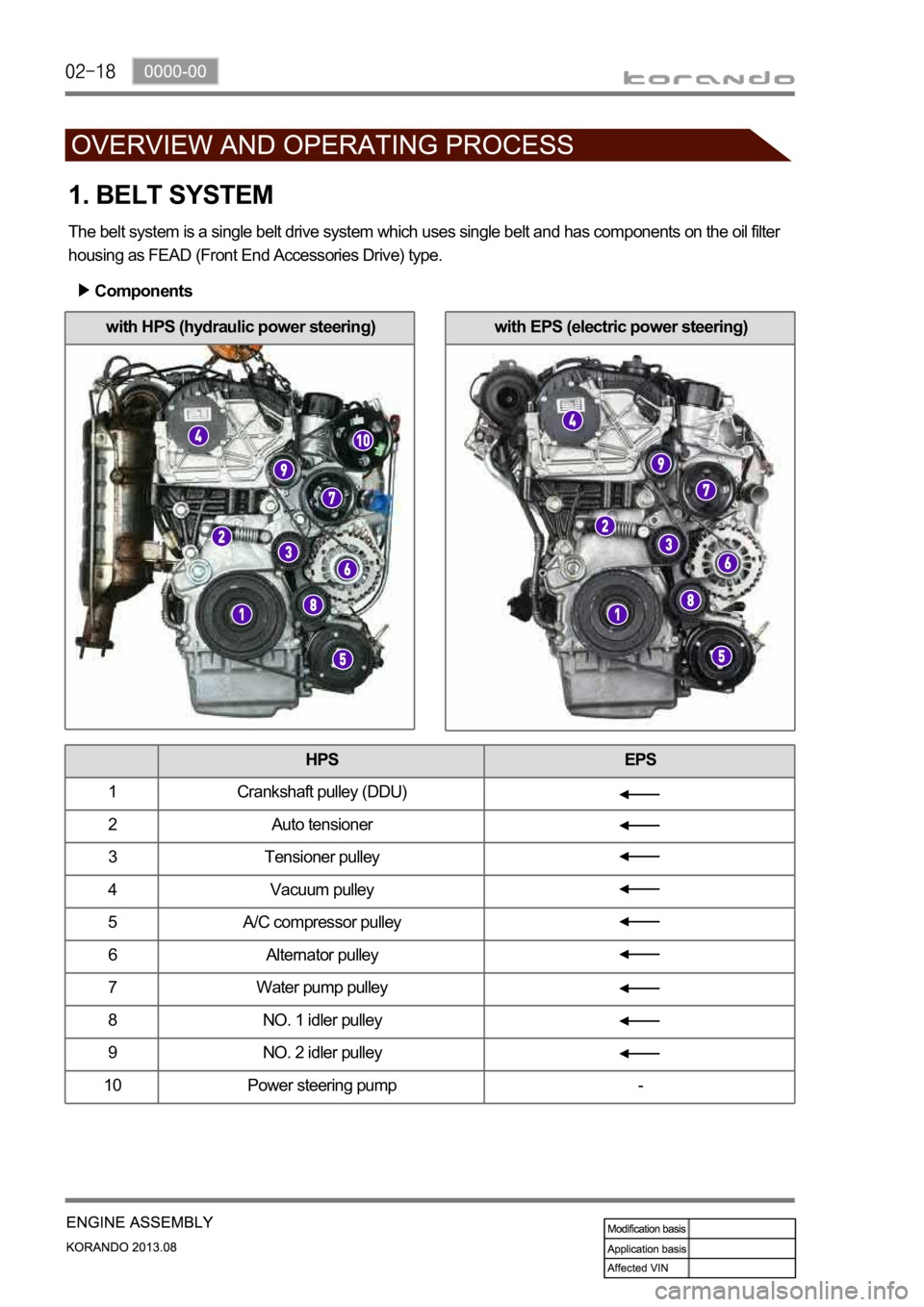
with EPS (electric power steering)with HPS (hydraulic power steering)
1. BELT SYSTEM
The belt system is a single belt drive system which uses single belt and has components on the oil filter
housing as FEAD (Front End Accessories Drive) type.
Components
HPS EPS
1 Crankshaft pulley (DDU)
2 Auto tensioner
3 Tensioner pulley
4 Vacuum pulley
5 A/C compressor pulley
6 Alternator pulley
7 Water pump pulley
8 NO. 1 idler pulley
9 NO. 2 idler pulley
10 Power steering pump -
Page 295 of 1336
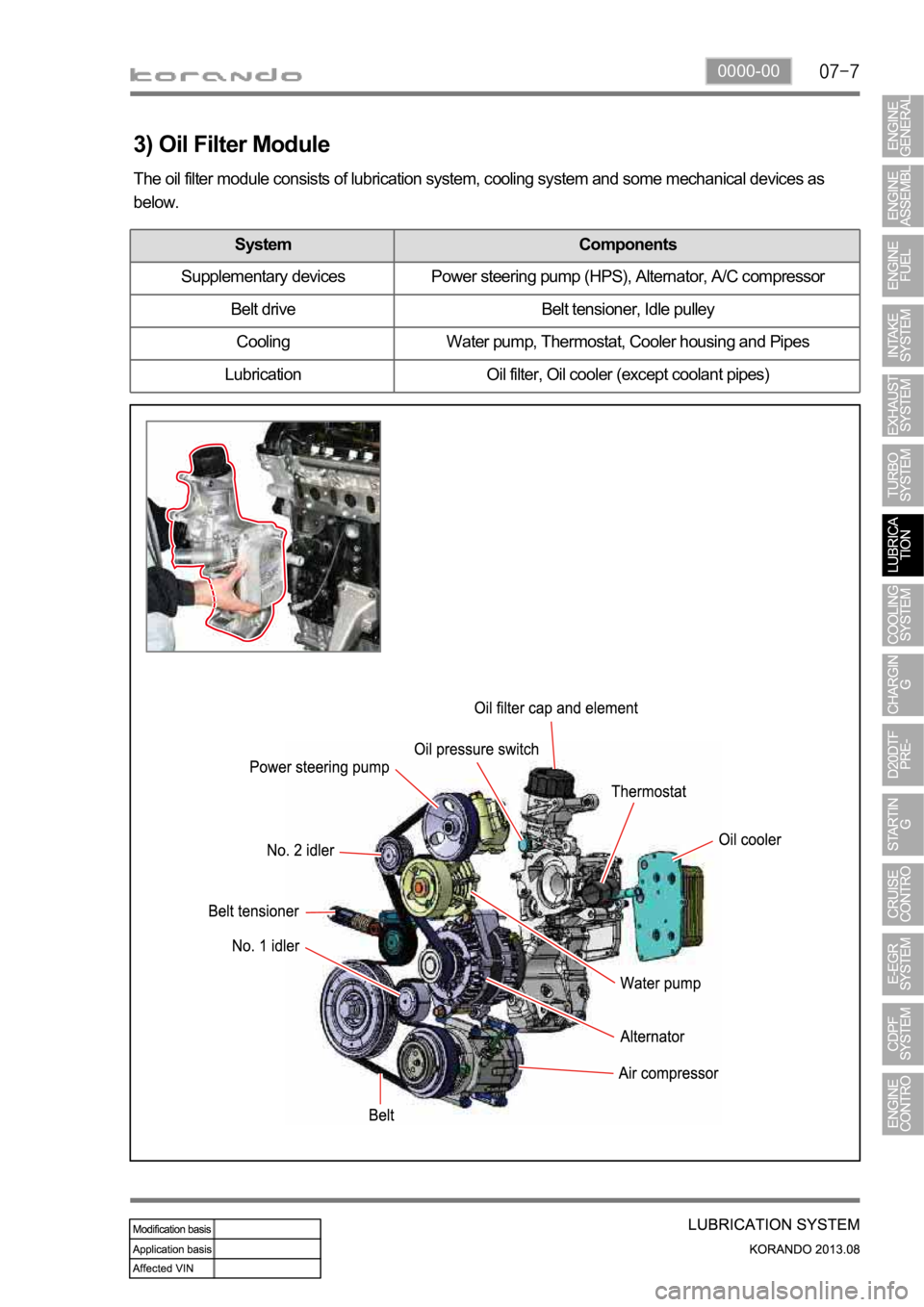
0000-00
3) Oil Filter Module
The oil filter module consists of lubrication system, cooling system and some mechanical devices as
below.
System Components
Supplementary devices Power steering pump (HPS), Alternator, A/C compressor
Belt drive Belt tensioner, Idle pulley
Cooling Water pump, Thermostat, Cooler housing and Pipes
Lubrication Oil filter, Oil cooler (except coolant pipes)
Page 307 of 1336
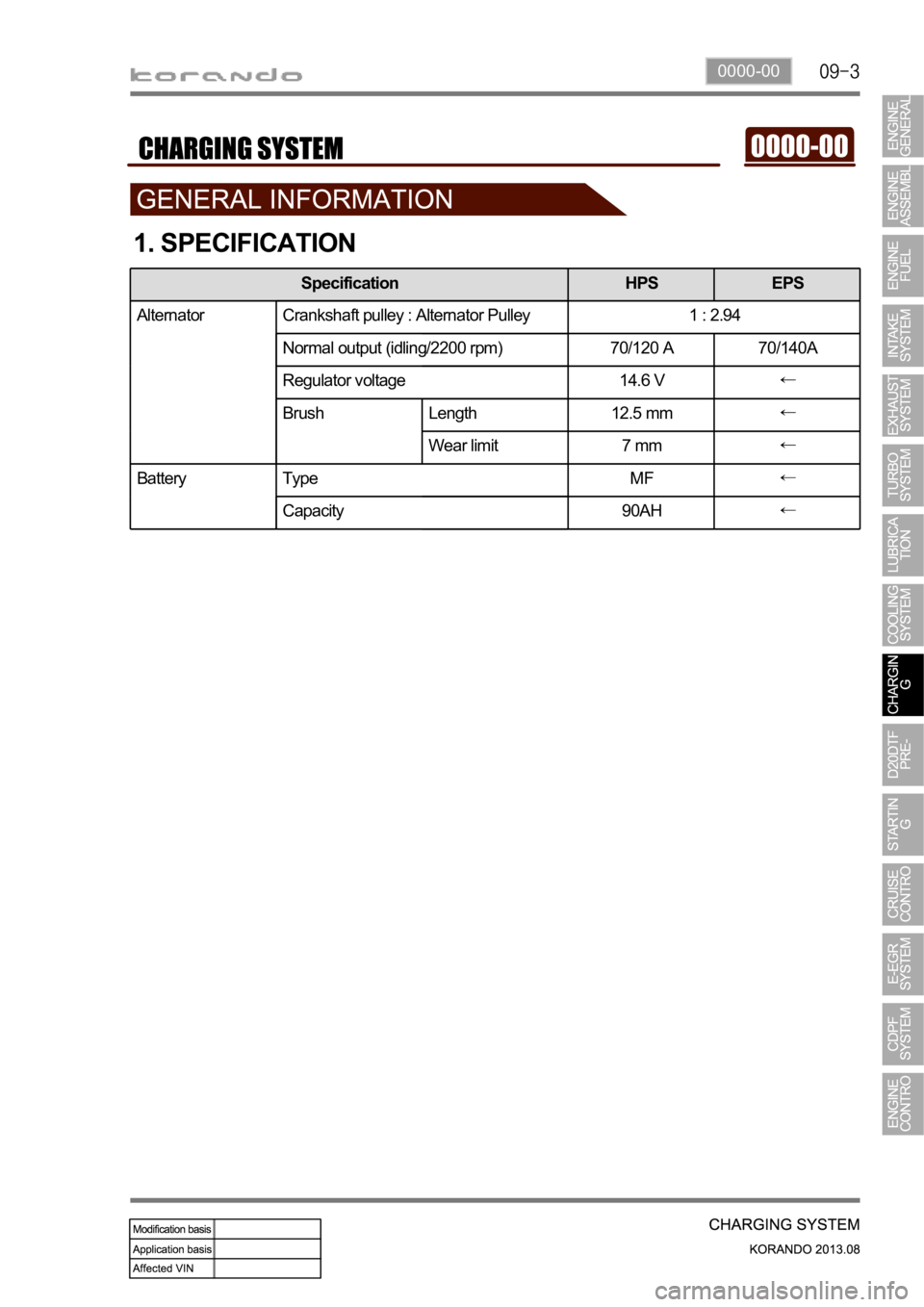
0000-00
1. SPECIFICATION
Specification HPS EPS
Alternator Crankshaft pulley : Alternator Pulley 1 : 2.94
Normal output (idling/2200 rpm) 70/120 A 70/140A
Regulator voltage 14.6 V
Brush Length 12.5 mm
Wear limit 7 mm
Battery Type MF
Capacity 90AH
Page 308 of 1336
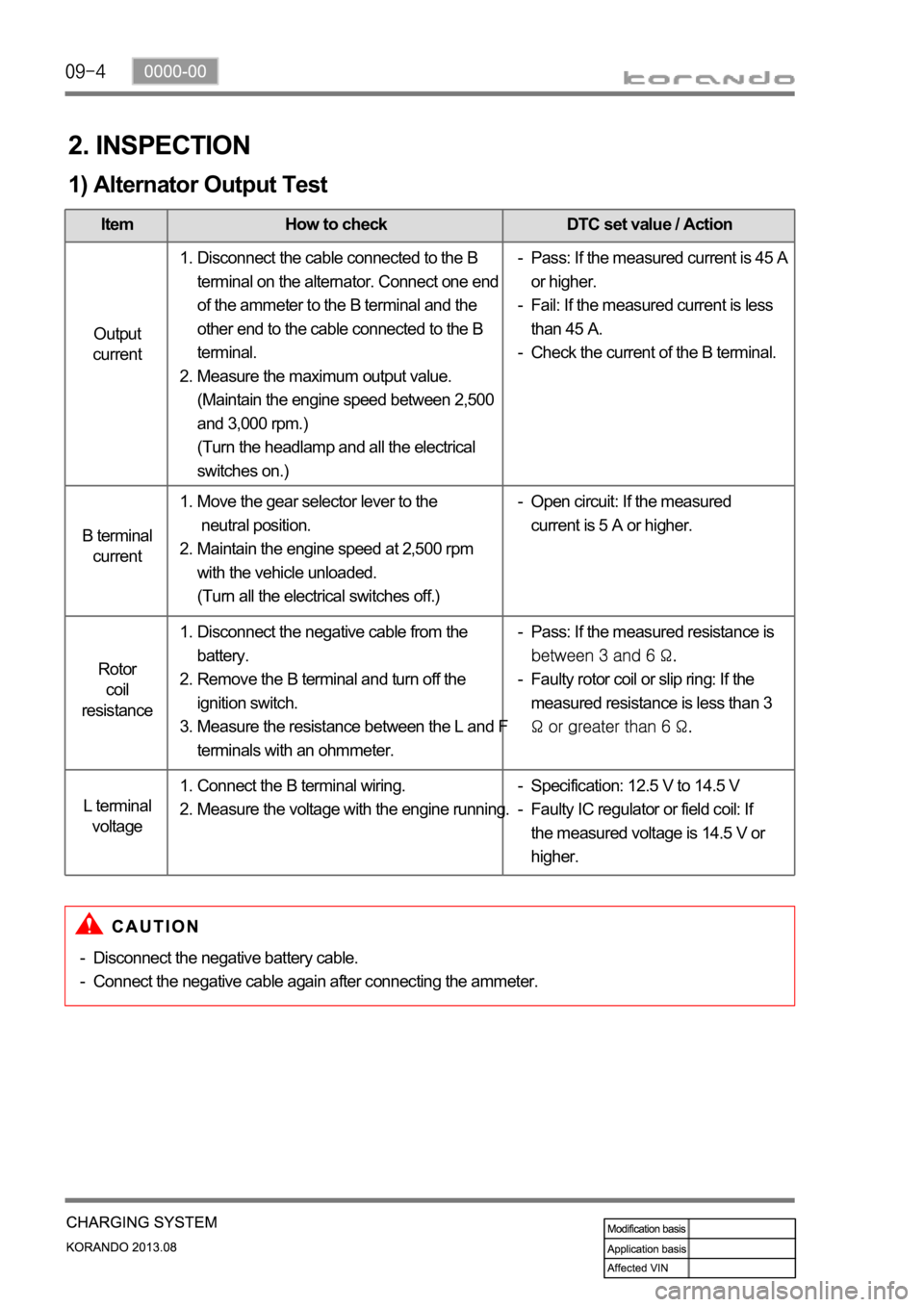
2. INSPECTION
1) Alternator Output Test
Item How to check DTC set value / Action
Output
current
B terminal
current
Rotor
coil
resistance
L terminal
voltage
Disconnect the cable connected to the B
terminal on the alternator. Connect one end
of the ammeter to the B terminal and the
other end to the cable connected to the B
terminal.
Measure the maximum output value.
(Maintain the engine speed between 2,500
and 3,000 rpm.)
(Turn the headlamp and all the electrical
switches on.) 1.
2.Pass: If the measured current is 45 A
or higher.
Fail: If the measured current is less
than 45 A.
Check the current of the B terminal. -
-
-
Move the gear selector lever to the
neutral position.
Maintain the engine speed at 2,500 rpm
with the vehicle unloaded.
(Turn all the electrical switches off.) 1.
2.Open circuit: If the measured
current is 5 A or higher. -
Disconnect the negative cable from the
battery.
Remove the B terminal and turn off the
ignition switch.
Measure the resistance between the L and F
terminals with an ohmmeter. 1.
2.
3.Pass: If the measured resistance is
Faulty rotor coil or slip ring: If the
measured resistance is less than 3
-
-
Connect the B terminal wiring.
Measure the voltage with the engine running. 1.
2.Specification: 12.5 V to 14.5 V
Faulty IC regulator or field coil: If
the measured voltage is 14.5 V or
higher. -
-
Disconnect the negative battery cable.
Connect the negative cable again after connecting the ammeter. -
-
Page 309 of 1336
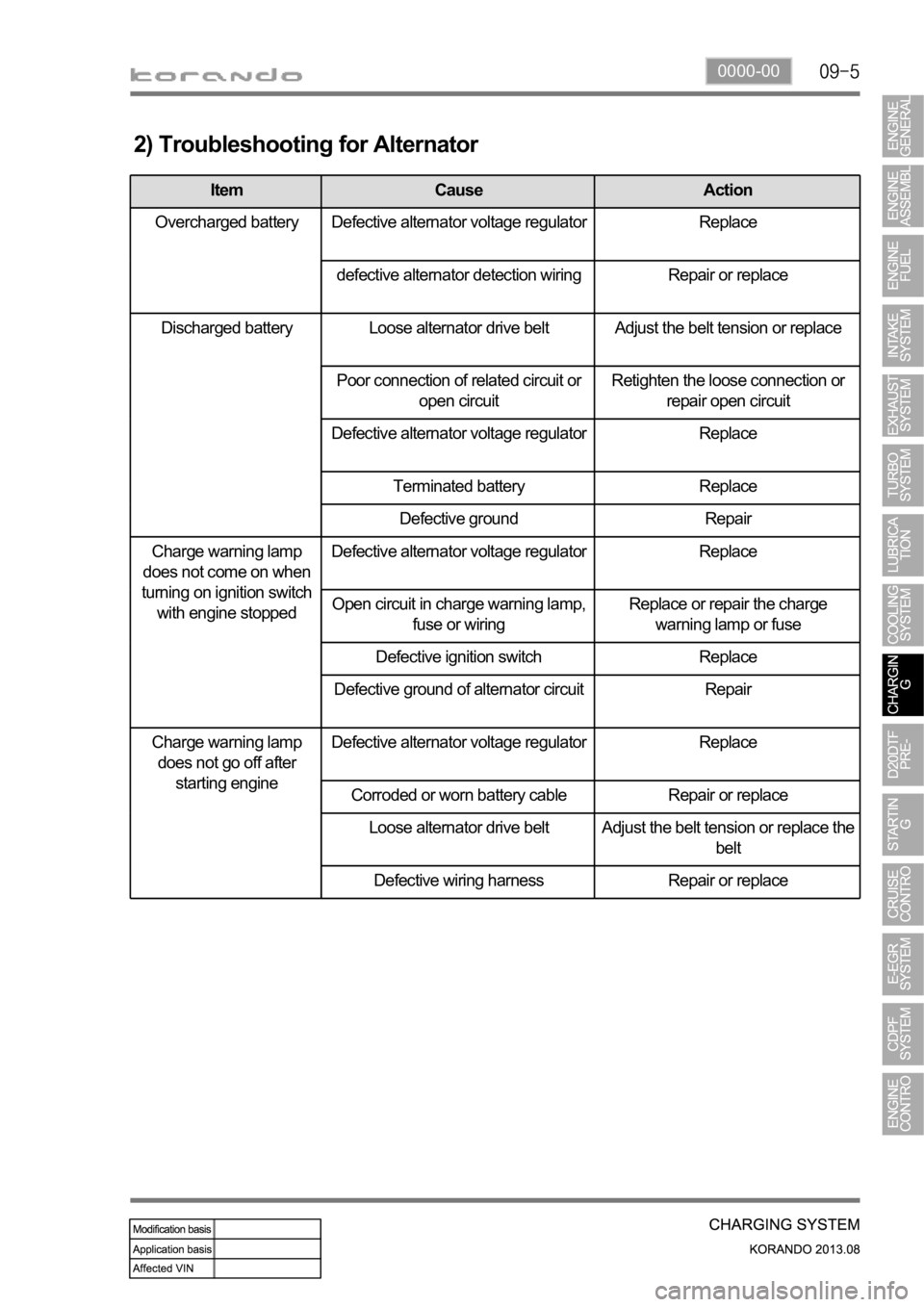
0000-00
2) Troubleshooting for Alternator
Item Cause Action
Overcharged battery Defective alternator voltage regulator Replace
defective alternator detection wiring Repair or replace
Discharged battery Loose alternator drive belt Adjust the belt tension or replace
Poor connection of related circuit or
open circuitRetighten the loose connection or
repair open circuit
Defective alternator voltage regulator Replace
Terminated battery Replace
Defective ground Repair
Charge warning lamp
does not come on when
turning on ignition switch
with engine stoppedDefective alternator voltage regulator Replace
Open circuit in charge warning lamp,
fuse or wiringReplace or repair the charge
warning lamp or fuse
Defective ignition switch Replace
Defective ground of alternator circuit Repair
Charge warning lamp
does not go off after
starting engineDefective alternator voltage regulator Replace
Corroded or worn battery cable Repair or replace
Loose alternator drive belt
Adjust the belt tension or replace the
belt
Defective wiring harness Repair or replace
Page 311 of 1336

0000-00
(1) Checking
Using battery tester
PASS (11.0 V or more): Explain to the customer that the battery is reusable.
Need to be charged (9.0 to 11.0 V): Charge the battery with a charger and reinstall it. Explain it to the
customer.
Need to be replaced (9.0 V or more): The battery should be replaced due to overdischarging. -
-
-
(2) How to use battery tester
How it works and How to use it
Determine battery capacity by fixing current
(load capacity) and time and varying voltage.
Determine battery capacity based on the
amount of voltage drop when discharging a
fixed load capacity (120 A) for 5 seconds.
Connect the tester to the battery and read the
display while applying a load for 5 seconds. -
-
-
How to read display
battery
(using a vehicle alternator and a battery
charger)
Red area on the left-hand side of OK
alternator
charged
Overcharged by an alternator -
-
-
-
-
-
Page 314 of 1336

Battery
It converts the chemical energy to the
electrical energy and supplies power to the
corresponding electric units when starting
the engine.Alternator
The alternator charges the battery and
supplies power to each electric unit by
converting the mechanical energy to the
electrical energy.
1. SYSTEM DESCRIPTION
1) Overview
The charge system is designed to supply electrical energy to the vehicle while driving, and supplies a
constant direct current voltage by converting mechanical rotational movement to electrical energy.
The voltage regulator on the back of the alternator controls the generated voltage in all rotating ranges
and adjusts the system voltage according to the electric load and ambient temperature change.
2) System Layout (Locations)
Page 315 of 1336
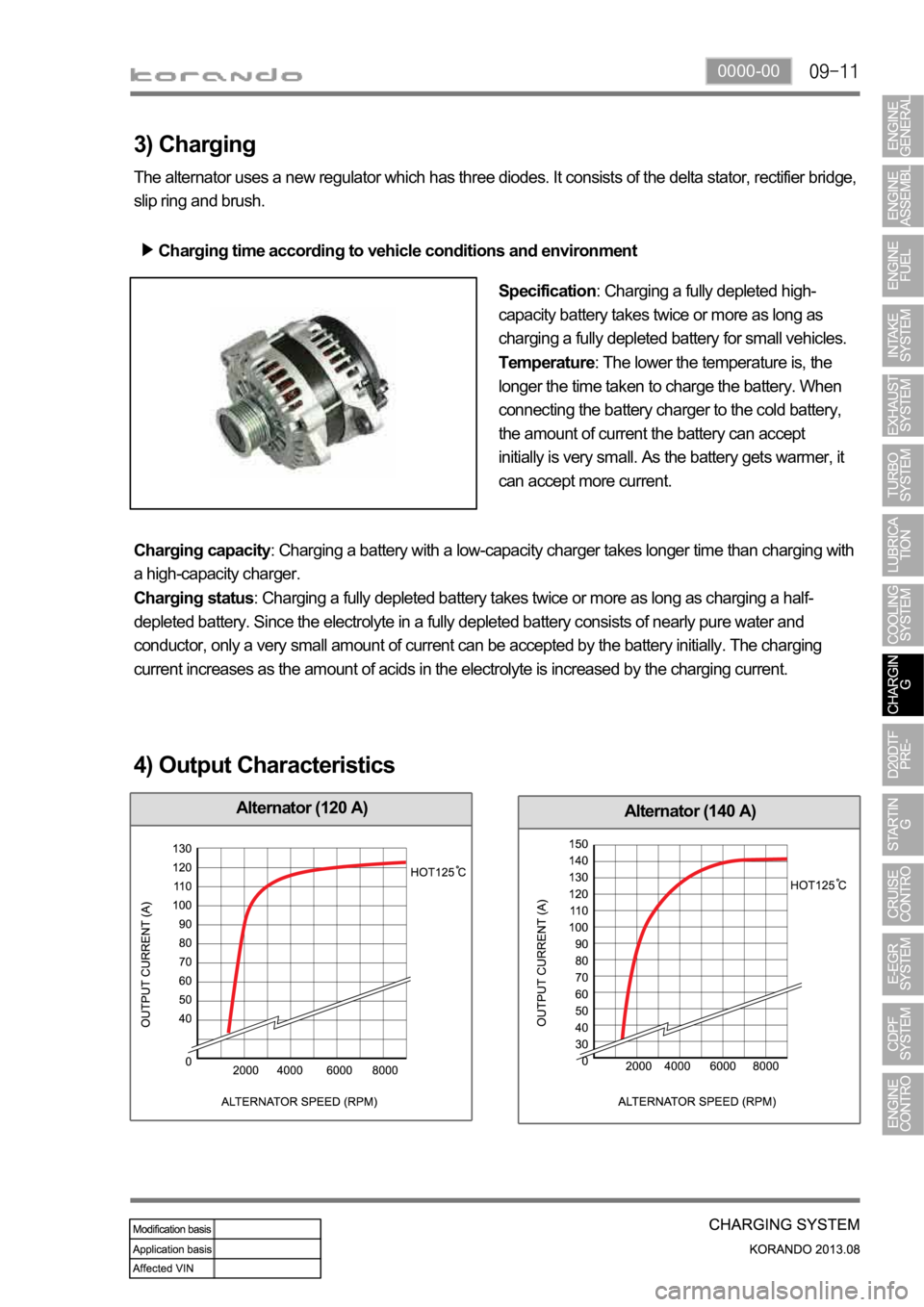
0000-00
Alternator (140 A)Alternator (120 A)
3) Charging
The alternator uses a new regulator which has three diodes. It consists of the delta stator, rectifier bridge,
slip ring and brush.
Charging time according to vehicle conditions and environment
Specification: Charging a fully depleted high-
capacity battery takes twice or more as long as
charging a fully depleted battery for small vehicles.
Temperature: The lower the temperature is, the
longer the time taken to charge the battery. When
connecting the battery charger to the cold battery,
the amount of current the battery can accept
initially is very small. As the battery gets warmer, it
can accept more current.
Charging capacity: Charging a battery with a low-capacity charger takes longer time than charging with
a high-capacity charger.
Charging status: Charging a fully depleted battery takes twice or more as long as charging a half-
depleted battery. Since the electrolyte in a fully depleted battery consists of nearly pure water and
conductor, only a very small amount of current can be accepted by the battery initially. The charging
current increases as the amount of acids in the electrolyte is increased by the charging current.
4) Output Characteristics